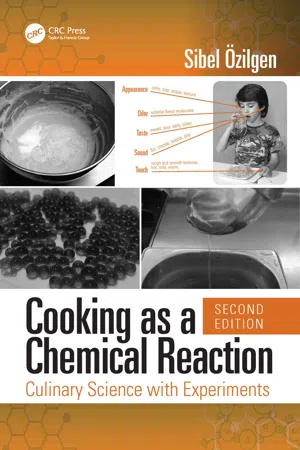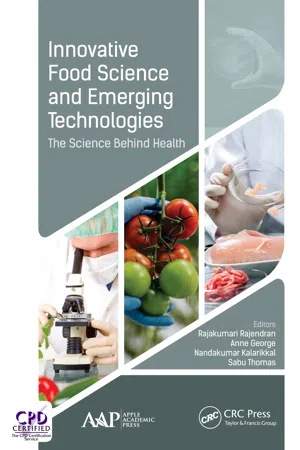Chemistry of food
The chemistry of food involves the study of the chemical processes and components that occur in food. This includes understanding the composition, structure, and properties of food molecules, as well as the chemical changes that occur during cooking, digestion, and storage. By examining the chemistry of food, scientists can gain insights into nutritional value, flavor development, and food safety.
5 Key excerpts on "Chemistry of food"
- eBook - ePub
- Jan Velisek, Richard Koplik, Karel Cejpek(Authors)
- 2020(Publication Date)
- Wiley-Blackwell(Publisher)
...It covers every aspect of food, incorporating and integrating concepts and information from many different fields, including the natural, technical, and social sciences. Primarily, it is based on chemical science (biochemistry; organic, inorganic, physical, and analytical chemistry), but it also draws heavily on some areas of physics (such as the mechanics of solids and liquids), biology (especially microbiology), biotechnology, some branches of medical science (human nutrition, human physiology, pharmacology, toxicology), and agricultural science (crop and livestock production, post‐harvest plant physiology, and post mortem muscle physiology). It also utilises the expertise of technical engineering disciplines, such as agricultural and food engineering, particularly in the form of genetic food engineering. And, from time to time, it calls on knowledge from economics, sociology, psychology, and other branches of social science. The most important building blocks of food science are food chemistry and food technology. Food chemistry deals not only with the composition of food raw materials and final food products, but also with the interactions and reactions of food components during the production, storage, and processing of food. Food technology runs the entire gamut from procuring food raw materials, through processing them into food products, to preserving, packaging, and distributing them. The shared goals and objectives of both disciplines are to enhance desirable positive changes and to prevent unwanted ones. Producing nutritious, safe, and, if possible, attractive food for human and animal consumption is the principal aim of both food chemistry and food technology. This book covers all aspects necessary for a comprehensive understanding of how food works. The 11 chapters that follow provide detailed knowledge of and modern insights into different classes of food constituents and their corresponding changes...
- eBook - ePub
- Kenneth J. Valentas, J. Peter Clark, Leon Levin(Authors)
- 2020(Publication Date)
- CRC Press(Publisher)
...4 Food Chemistry I. Scope of Chapter Those engaged in processing food should understand the basic chemistry and physics of food materials. Often the engineer in the food processing industry has acquired just enough knowledge of food chemistry to size a heat exchanger, design a piping system, and so on. This information has often been obtained in an unstructured way dependent on need and is essentially a random walk in the world of food chemistry. This chapter is designed to pull together some basic concepts of food chemistry that are of particular interest for engineering applications. For those desiring a more in-depth discussion the reader is referred to Fennema’s (6) textbook, which is detailed and also contains a wealth of useful references. II. Enzymes and Human Nutrition It is difficult to discuss food in an entirely objective manner because everyone has likes, dislikes, prejudices, and opinions. For those of us engaged in processing food, it is important to understand the basic chemistry and physics of food materials. The ultimate purpose of food is to sustain biological systems, and, in this case, the human organism is the prime concern. There is considerable controversy over the role of foods and food ingredients in human nutrition. Nutrition is a very complicated science and the subject of extensive research. It is not possible to treat the subject in any depth here. Still, it is important for engineers to understand the fundamentals of human nutrition even if on a very elementary level. III. Human Chemical Factory It is instructive to view the human body as a chemical factory with specific inputs and outputs, such as shown in Fig. 1. In this simplified model, foods or nutrients that can be categorized chemically as lipids, proteins, carbohydrates, water, minerals, and vitamins along with oxygen, which is obtained from the air we breathe, are utilized by the body to support life...
- eBook - ePub
Cooking as a Chemical Reaction
Culinary Science with Experiments
- Z. Sibel Ozilgen(Author)
- 2019(Publication Date)
- CRC Press(Publisher)
...C HAPTER 2 Basic Food Chemistry Food Processing Is All about Chemistry Foods are made up of chemical compounds that include water, proteins, lipids, carbohydrates, vitamins, and minerals. The composition of the foods determines both physical and chemical properties of the foods. During preparation and processing, such as cooking and drying, a series of chemical reactions occurs in foods. The structures of the chemical compounds are changed and new food products are formed. These types of irreversible changes are called chemical changes. Basic food chemistry primarily deals with the chemical composition of foods; the chemical structures and the properties of primary food compounds, which are water, proteins, lipids, and carbohydrates; and the chemical changes that the foods undergo during food processing, storage, and transportation. Knowledge of basic chemistry concepts is required to understand basic food chemistry. An atom is the smallest unit of an element. Atoms are made up of three particles: protons, neutrons, and electrons (Figure 2.1). Protons and neutrons are found in the nucleus, while the electrons are arranged in shells around the nucleus. The electrons found in the outer shells are called the valence electrons. The valence electrons can be used to form the chemical bonds. All atoms in a molecule must have eight valence electrons to become stable (the Octet Rule). Atoms whose outer shells are filled with electrons have low energy, and they are said to be stable. For most atoms, the outermost shell is incomplete. The atoms are connected to each other by chemical bonds and form molecules, such as NaCl (sodium chloride) and H 2 O (water) to achieve lower state of energy and become stable. There are different types of bonds that hold atoms of the molecules together...
- eBook - ePub
- Pieter Walstra(Author)
- 2002(Publication Date)
- CRC Press(Publisher)
...Experience has shown that physicochemical aspects are also of great importance in foods and food processing. This does not mean that all of the phenomena involved are of a physical nature: it is seen from the examples given that food chemistry, engineering, and even microbiology can be involved as well. Numerous other examples are given in this book. The problems encountered in food science and technology are generally quite complex, and this also holds for physicochemical problems. In the first place, nearly all foods have a very wide and complex composition; a chemist might call them dirty systems. Anyway, they are far removed from the much purer and dilute systems discussed in elementary textbooks. This means that the food is not in thermodynamic equilibrium and tends to change in composition. Moreover, several changes may occur simultaneously, often influencing each other. Application of physicochemical theory may also be difficult, since many food systems do not comply with the basic assumptions underlying the theory needed. In the second place, most foods are inhomogeneous systems. Consequently, various components can be in different compartments, greatly enhancing complexity. This means that the system is even farther removed from thermodynamic equilibrium than are most homogeneous systems. Moreover, several new phenomena come into play, especially involving colloidal interactions and surface forces. These occur on a larger than molecular scale. Fortunately, the study of mesoscopic physics—which involves phenomena occurring on a scale that is larger than that of molecules but (far) smaller than can be seen with the naked eye—has made great progress in recent times. In the third place, a student of the physical Chemistry of foods has to become acquainted with theories derived from a range of disciplines, as a look at the table of contents will show...
- Sabu Thomas, Rajendran Rajakumari, Anne George, Nandakumar Kalarikkal, Sabu Thomas, Rajendran Rajakumari, Anne George, Nandakumar Kalarikkal(Authors)
- 2018(Publication Date)
- Apple Academic Press(Publisher)
...PREFACE Food can be defined as the nutritive material taken by an organism for growth, work, and for maintaining the vital processes. Food sustains life, and it is viewed as a pure source of nutrition. The study of food science is used to modify and improve the food in our society. The knowledge of food science and nutrition helps to improve the health and quality of life and is certainly something everyone is passionate about. Food science and technology is the field devoted to the application of basic sciences and engineering to study the nature of foods, deterioration, the principles of food processing, and the improvement of foods for the consuming public. The field of food technology is growing rapidly, and its development is making tremendous impact on life sciences and public health. The importance and significance can be gauged by the fact that it has made huge advancements over the course of time and is continuing to influence various sector. ICAFST—2015, the First International Conference on Advances in Food Science and Technology, was held on November 20–22, 2015, in Kottayam, Kerala, India. It was jointly organized by Ayurveda-und Venen-Klinik, the Institute for Holistic Medical Sciences (IHMS), and Institute of Macromolecular Science and Engineering (IMSE). The new emerging field of food science and technology has put forward many challenging opportunities in the use of these smart healthy foods. Food technologists show great interest in new strategies regarding food chemistry, a main branch of food technology. Recently food engineering has gained much interest, and due to its unique properties is receiving global attention nowadays. The growing interest among the industrialists and researchers in the field of food technology is the driving force behind this book. The conference emphasized various aspects of preparation, characterization, morphology, properties, recyclability and advances, and challenging opportunities of food science...




